How to choose the best app monetization strategy for you?
It’s great that you have an app that’s helping people. But how would you monetize it?
With almost two million apps on Google Play, there are dozens of different app categories as well. Just like the nature and use of apps are different, monetizing apps depending on their category may differ.
The way you monetize your app will depend on how you want to approach your business. Are you looking to monetize short-term or long-term? Do you have substantial initial funding or not?
Here are the various ways you can monetize your app.
1. In-App Advertising
Monetizing your app through in-app advertising involves generating revenue through 3rd party ads. Advertisers will pay you to show their ads on your app. Apps that use this method are one of the most loved apps by users for the following reasons:
- They’re usually free
- They play out like a premium experience
- This model is centered around community engagement.
- These apps require consistent updates to engage their users.
However, with the lack of upfront fees and in-app purchases, this model relies on a vast user base to fully optimize income through ad revenue.
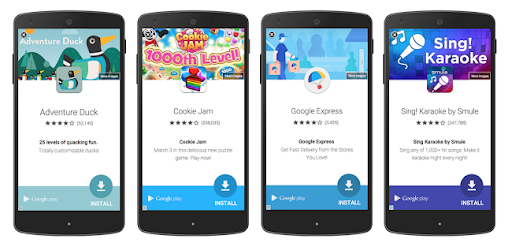
Source: Phoneia
To monetize through in-app advertising, developers need to allocate resources to foster a massive, consistently-engaged community. For that, they need to invest heavily in community engagement and market research. Utilize online survey platforms to collect data and nurture your user base.
It would help if you also incentivized friend invites and community-building actions such as sharing screenshots.
For this reason, online multiplayer games can utilize this monetization method most effectively. This efficiency is due to their ability to incentivize engagement, along with their community-building nature.
Another thing to consider is that since the app’s income hinges on both ads and an active user base, the ads mustn’t ruin the users’ experience. Respecting your users’ in-app experience by utilizing different ad formats ensures that they stay around for longer.
The drawback to this model, though, is that you may not monetize immediately. Since the significant gains will only come in when you’ve built up your user base, starting will be rough and require some funding.
2. The Freemium Business Model and In-App Purchases
‘Freemium’ software is the free version of otherwise paid software. This software is a customer acquisition method that gives the users a completely free experience, warming them up to a purchase.
Similar to the In-App Advertising model, freemium apps are free upfront. However, they monetize by users paying a subscription fee, buying in-app items, or paying a one-time fee to unlock all features.
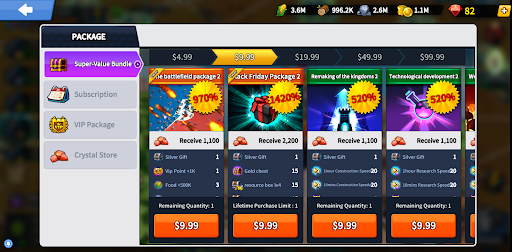
Your free experience should work as part of a funnel to get your customers to purchase to monetize from this method, just like any sales funnel. It includes utilizing space in your free experience as your own ad space. Give out limited-time offers and limited-time items, reward users with discounts for engaged users, and more.
Unlike an In-App Advertising monetization method, a huge engaged community isn’t essential to a freemium business model. Assuming a healthy conversion rate, your revenue will scale as your community grows. Means you could still monetize from about 1,000 to 10,000 users.
Just be sure that your premium experience and paid items keep your customers happy.
3. The Model of Paid Download
Unlike previous examples, the paid download model requires an initial purchase from the user before even experiencing the app. This connection means that downloads are directly proportional to revenue.
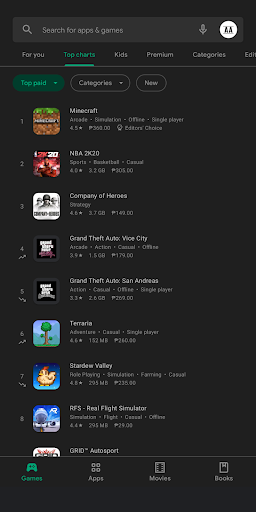
However, unlike the mainstream gaming industry, there’s a growing popularity of free apps in the mobile market. A paid download might not be the best approach at this time unless:
- You have effective marketing and sales funnel
- You’ve developed a successful franchise (i.e., Star Wars, Lord of the Rings, Asphalt)
- You’re a household name in gaming (i.e., Minecraft, Grand Theft Auto)
- You’re an established app in your given category
- Your entry price is near free
Paid downloads are excellent for short-term revenue. The reason for this is that upon user download, developers instantly get sales. However, with the absence of an initial experience, users would be very reluctant to purchase the app. Developers will need to rely on marketing and sales if they don’t have an established name yet.
That also doesn’t mean developers can slack off on app maintenance and updates after investing in marketing. Ensuring the quality and tip-top shape of the app also means better reviews. These testimonials will get reluctant users to pay for your app and rank your app higher on the paid category list.
4. The Subscription Model
A subscription model monetizes not from user downloads but user subscriptions. Hence, this model requires a more significant commitment from the user than a paid download.
This model is often used in conjunction with a free trial or a freemium model. Services like Netflix and Canva give their users free trials of all their features unlocked. The free trial warms users up to a subscription. These companies often send bulk cold emails to facilitate these conversions. Developers also offer annual subscriptions, apart from monthly subscriptions, to save users money.
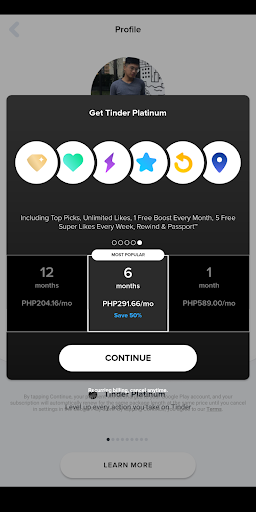
The benefit of a subscription model overpaid downloads is that users typically have a higher lifetime value to subscription services than one-time payments. It also allows developers to solely focus on innovating their subscribed platform instead of making new products.
Subscription monetization is best used for continuously innovating services such as VPNs, antivirus software, dating apps, and streaming services.
Games would not benefit as much from this form of monetization. This is because there’s a growing number of competition utilizing monetization methods that make the experience free for users. Additionally, the game market typically has a lower age bracket, prompting in-app purchases for more practical use.
5. The Facilitation Model
Apps that use the facilitation model facilitate transactions between parties. They monetize by charging a percentage from the sales of merchants on their platform.
For apps that use this model, users are composed of two parties-- merchants and customers.
Similar to a marketplace, apps that use this model connect customers to 3rd party services. These may include food, wares, carpool services, ap style writers, commissioned art, and more. Though they facilitate interaction between two unrelated parties, dating apps are not facilitation apps since they don’t monetize from the exchange of two dates.
An efficient facilitation app is:
- Community-driven
- Develops as the community develops
- Earns more revenue from increasing user volume
- It is an efficient solution for clients to get work done
- Provides a platform for trades/merchants to monetize
- Facilitates an ecosystem that boosts the economy of a particular industry.
Facilitation apps provide some of the most efficient solutions to an industry and require heavy funding to get the initial merchants enticed and onboarded. These apps are also some of the most maintenance-heavy apps since transactions are done exclusively online.
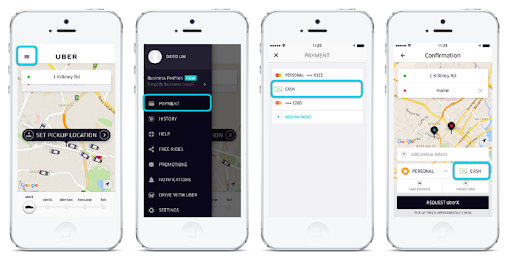
Source: Uber
It is for this reason that a facilitation model needs a thriving community to be sustainable. However, developers must ensure that merchants and customers are at a steady proportion. Too many customers could mean lousy customer service due to the limited number of merchants. Too many merchants, on the other hand, means a near non-existent ecosystem on your app.
Once a healthy number of merchants-to-customers is reached, its passionate community could sustain the facilitation app.
Uber connects drivers with passengers through the app. Passengers book a carpool, and Uber connects the passengers to nearby available drivers. Uber takes a 25% cut from its carpool drivers.
Some eCommerce sites that serve as marketplaces also take a commission from their merchants. Alibaba and Amazon are famous examples.
If you want to solve an industry problem by connecting people and monetizing from it, look into a facilitation app.
6. The Model of Combination
The models, as mentioned earlier, may be combined to create monetization methods that address the weakness of a primary method. Combining them may also tackle any compromises on user experience that anyone method results in.
Take, for example, a subscription app. Since subscriptions require a hefty commitment from users due to monthly payments, developers may integrate a freemium model with the subscribed service. Doing this may address the concerns of a huge commitment.
An effective combination would be the in-app advertising/freemium combination. Since freemium apps only make revenue when users pay for premium features, developers utilize the free version of their software as ad space. Doing this allows the free version of their app to generate revenue itself.
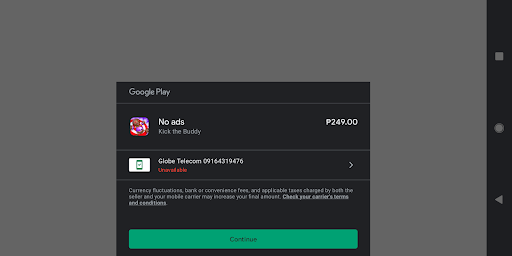
Some apps would even combine in-app ads and purchases to remind free users that their experience isn’t premium. What games would do is that they would offer a one-time purchase option to remove ads, allowing the user to immerse himself in what the game has to offer.
If you’re concerned about the drawbacks of any monetization method or are looking to create a premium experience for free users without drawbacks to your app’s revenue, try to combine.
Bottomline
Different monetization methods demand different things. Each one is best suited for a different app category, whether you have substantial initial funding and if you’re after short-term or long-term revenue.
In-App advertising and a facilitation model require a thriving user base that frequents your app. In-App advertising is optimized with a huge user base, while a facilitation model is only possible with a healthy ecosystem of merchants and customers. These are both long-term monetization methods. If you wish to foster and engage with your community, do proper market research. Survey platforms may help with that.
A freemium business model is a free version of a paid premium app, while in-app purchases are paid in-game items of a free game. These may be monetized short-term because any purchase made in the app would directly translate into sales.
Paid downloads are downloads that directly translate into sales, making them optimal for short-term revenue. An effective marketing funnel should be paired with a paid download monetization method. On the other hand, subscription apps are best combined with free trials. They also provide a higher customer lifetime value to developers.
Developers may combine any two or more of these methods to create a hybrid monetization method. Whichever method you choose, always note that user experience is just as crucial as your optimized revenue.
About the autor: David Campbell is a digital marketing specialist at Ramp Ventures. He helps manage the content marketing team at Right Inbox. When he's not working, he enjoys traveling and trying to learn Spanish.

Copyright © . All Rights Reserved